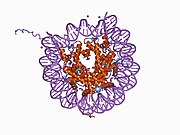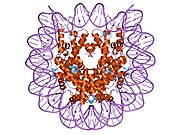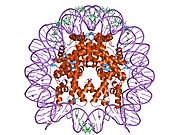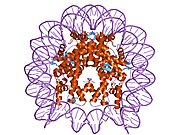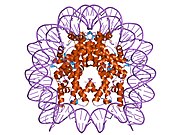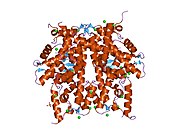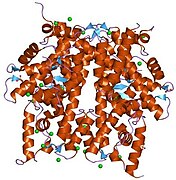HIST1H2BK
| H2BC12 | |||||||||||||||||||||||||||||||||||||||||||||||||||
|---|---|---|---|---|---|---|---|---|---|---|---|---|---|---|---|---|---|---|---|---|---|---|---|---|---|---|---|---|---|---|---|---|---|---|---|---|---|---|---|---|---|---|---|---|---|---|---|---|---|---|---|
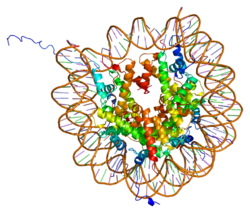 | |||||||||||||||||||||||||||||||||||||||||||||||||||
| |||||||||||||||||||||||||||||||||||||||||||||||||||
| Identifiers | |||||||||||||||||||||||||||||||||||||||||||||||||||
| Aliases | H2BC12, H2B/S, H2BFAiii, H2BFT, H2BK, histone cluster 1, H2bk, histone cluster 1 H2B family member k, H2B clustered histone 12, HIST1H2BK | ||||||||||||||||||||||||||||||||||||||||||||||||||
| External IDs | OMIM: 615045; MGI: 2448399; HomoloGene: 135980; GeneCards: H2BC12; OMA:H2BC12 - orthologs | ||||||||||||||||||||||||||||||||||||||||||||||||||
| |||||||||||||||||||||||||||||||||||||||||||||||||||
| |||||||||||||||||||||||||||||||||||||||||||||||||||
| |||||||||||||||||||||||||||||||||||||||||||||||||||
| |||||||||||||||||||||||||||||||||||||||||||||||||||
| |||||||||||||||||||||||||||||||||||||||||||||||||||
| Wikidata | |||||||||||||||||||||||||||||||||||||||||||||||||||
| |||||||||||||||||||||||||||||||||||||||||||||||||||
Histone H2B type 1-K is a protein that in humans is encoded by the HIST1H2BK gene.[5][6]
Histones are basic nuclear proteins that are responsible for the nucleosome structure of the chromosomal fiber in eukaryotes. Two molecules of each of the four core histones (H2A, H2B, H3, and H4) form an octamer, around which approximately 146 bp of DNA is wrapped in repeating units, called nucleosomes. The linker histone, H1, interacts with linker DNA between nucleosomes and functions in the compaction of chromatin into higher order structures. This gene encodes a member of the histone H2B family. This gene is found in the histone microcluster on chromosome 6p21.33.[6]
Interactions
HIST1H2BK has been shown to interact with HIRA.[7]
References
- ^ a b c GRCh38: Ensembl release 89: ENSG00000197903 – Ensembl, May 2017
- ^ a b c GRCm38: Ensembl release 89: ENSMUSG00000062727 – Ensembl, May 2017
- ^ "Human PubMed Reference:". National Center for Biotechnology Information, U.S. National Library of Medicine.
- ^ "Mouse PubMed Reference:". National Center for Biotechnology Information, U.S. National Library of Medicine.
- ^ Marzluff WF, Gongidi P, Woods KR, Jin J, Maltais LJ (Oct 2002). "The human and mouse replication-dependent histone genes". Genomics. 80 (5): 487–98. doi:10.1016/S0888-7543(02)96850-3. PMID 12408966.
- ^ a b "Entrez Gene: HIST1H2BK histone cluster 1, H2bk".
- ^ Lorain, S; Quivy J P; Monier-Gavelle F; Scamps C; Lécluse Y; Almouzni G; Lipinski M (Sep 1998). "Core Histones and HIRIP3, a Novel Histone-Binding Protein, Directly Interact with WD Repeat Protein HIRA". Mol. Cell. Biol. 18 (9). UNITED STATES: 5546–56. doi:10.1128/MCB.18.9.5546. ISSN 0270-7306. PMC 109139. PMID 9710638.
Further reading
- Dobner T, Wolf I, Mai B, Lipp M (1992). "A novel divergently transcribed human histone H2A/H2B gene pair". DNA Seq. 1 (6): 409–13. doi:10.3109/10425179109020799. PMID 1768865.
- Frohm M, Gunne H, Bergman AC, et al. (1996). "Biochemical and antibacterial analysis of human wound and blister fluid". Eur. J. Biochem. 237 (1): 86–92. doi:10.1111/j.1432-1033.1996.0086n.x. PMID 8620898.
- El Kharroubi A, Piras G, Zensen R, Martin MA (1998). "Transcriptional Activation of the Integrated Chromatin-Associated Human Immunodeficiency Virus Type 1 Promoter". Mol. Cell. Biol. 18 (5): 2535–44. doi:10.1128/mcb.18.5.2535. PMC 110633. PMID 9566873.
- Lorain S, Quivy JP, Monier-Gavelle F, et al. (1998). "Core Histones and HIRIP3, a Novel Histone-Binding Protein, Directly Interact with WD Repeat Protein HIRA". Mol. Cell. Biol. 18 (9): 5546–56. doi:10.1128/MCB.18.9.5546. PMC 109139. PMID 9710638.
- Albig W, Trappe R, Kardalinou E, et al. (1999). "The human H2A and H2B histone gene complement". Biol. Chem. 380 (1): 7–18. doi:10.1515/BC.1999.002. PMID 10064132. S2CID 12807248.
- Ahn J, Gruen JR (1999). "The genomic organization of the histone clusters on human 6p21.3". Mamm. Genome. 10 (7): 768–70. doi:10.1007/s003359901089. PMID 10384058. S2CID 28275496.
- Deng L, de la Fuente C, Fu P, et al. (2001). "Acetylation of HIV-1 Tat by CBP/P300 increases transcription of integrated HIV-1 genome and enhances binding to core histones". Virology. 277 (2): 278–95. doi:10.1006/viro.2000.0593. PMID 11080476.
- Deng L, Wang D, de la Fuente C, et al. (2001). "Enhancement of the p300 HAT activity by HIV-1 Tat on chromatin DNA". Virology. 289 (2): 312–26. doi:10.1006/viro.2001.1129. PMID 11689053.
- Kim HS, Cho JH, Park HW, et al. (2002). "Endotoxin-neutralizing antimicrobial proteins of the human placenta". J. Immunol. 168 (5): 2356–64. doi:10.4049/jimmunol.168.5.2356. PMID 11859126.
- Strausberg RL, Feingold EA, Grouse LH, et al. (2003). "Generation and initial analysis of more than 15,000 full-length human and mouse cDNA sequences". Proc. Natl. Acad. Sci. U.S.A. 99 (26): 16899–903. Bibcode:2002PNAS...9916899M. doi:10.1073/pnas.242603899. PMC 139241. PMID 12477932.
- Cheung WL, Ajiro K, Samejima K, et al. (2003). "Apoptotic phosphorylation of histone H2B is mediated by mammalian sterile twenty kinase". Cell. 113 (4): 507–17. doi:10.1016/S0092-8674(03)00355-6. PMID 12757711. S2CID 21854.
- Tollin M, Bergman P, Svenberg T, et al. (2004). "Antimicrobial peptides in the first line defence of human colon mucosa". Peptides. 24 (4): 523–30. doi:10.1016/S0196-9781(03)00114-1. PMID 12860195. S2CID 7435936.
- Mungall AJ, Palmer SA, Sims SK, et al. (2003). "The DNA sequence and analysis of human chromosome 6". Nature. 425 (6960): 805–11. Bibcode:2003Natur.425..805M. doi:10.1038/nature02055. PMID 14574404.
- Lusic M, Marcello A, Cereseto A, Giacca M (2004). "Regulation of HIV-1 gene expression by histone acetylation and factor recruitment at the LTR promoter". EMBO J. 22 (24): 6550–61. doi:10.1093/emboj/cdg631. PMC 291826. PMID 14657027.
- Howell SJ, Wilk D, Yadav SP, Bevins CL (2004). "Antimicrobial polypeptides of the human colonic epithelium". Peptides. 24 (11): 1763–70. doi:10.1016/j.peptides.2003.07.028. PMID 15019208. S2CID 28953527.
- Gerhard DS, Wagner L, Feingold EA, et al. (2004). "The Status, Quality, and Expansion of the NIH Full-Length cDNA Project: The Mammalian Gene Collection (MGC)". Genome Res. 14 (10B): 2121–7. doi:10.1101/gr.2596504. PMC 528928. PMID 15489334.
- Andersen JS, Lam YW, Leung AK, et al. (2005). "Nucleolar proteome dynamics". Nature. 433 (7021): 77–83. Bibcode:2005Natur.433...77A. doi:10.1038/nature03207. PMID 15635413. S2CID 4344740.
- Tsunaka Y, Kajimura N, Tate S, Morikawa K (2005). "Alteration of the nucleosomal DNA path in the crystal structure of a human nucleosome core particle". Nucleic Acids Res. 33 (10): 3424–34. doi:10.1093/nar/gki663. PMC 1150222. PMID 15951514.
- Golebiowski F, Kasprzak KS (2007). "Inhibition of core histones acetylation by carcinogenic nickel(II)". Mol. Cell. Biochem. 279 (1–2): 133–9. doi:10.1007/s11010-005-8285-1. PMID 16283522. S2CID 25071586.





